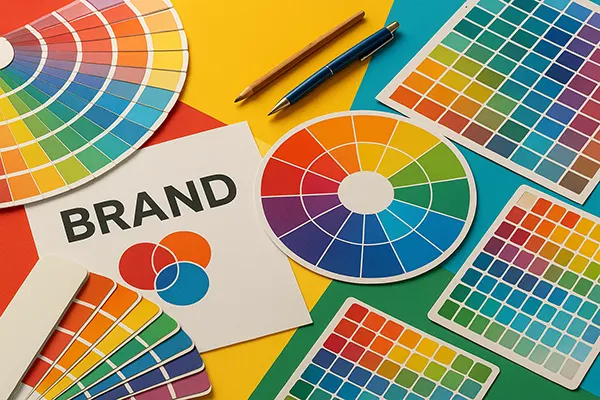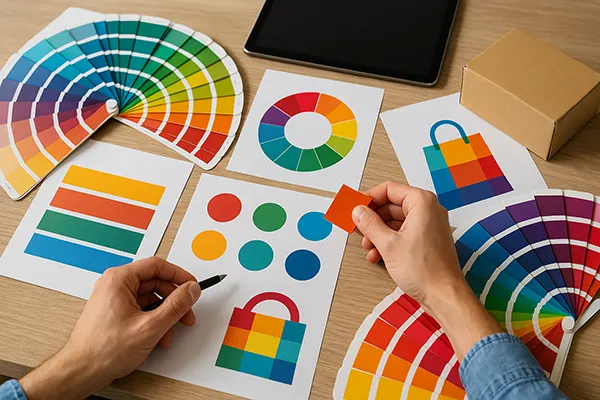Psychology of Colour in Marketing Design: How Colours Shape Brand Perception

Colours are more than just visual elements; they are powerful tools that influence human emotions, decisions, and brand engagement. In the realm of marketing design, colour psychology plays a pivotal role in creating brand identities and shaping consumer perceptions. By understanding the psychological triggers associated with different hues, marketers and designers can evoke specific feelings and behaviours, increasing the effectiveness of their campaigns and branding strategies.
Understanding the Basics of Colour Psychology in Branding
Colour psychology refers to the study of how different colours influence human behaviour and emotional responses. Each colour elicits specific associations based on cultural norms, personal experiences, and psychological conditioning. For example, red is typically associated with urgency, passion, and power, whereas blue conveys trust, calmness, and reliability. These subconscious connections make colour a critical factor in branding, as it helps companies convey the right message without using a single word.
Studies show that consumers make a judgement about a product within 90 seconds of initial interaction, and up to 90% of that assessment is based on colour alone. As a result, brand identity is closely linked to colour schemes, affecting brand recognition and trust. A consistent and well-thought-out colour palette ensures visual coherence across all platforms and marketing materials, enhancing memorability and loyalty.
Brand success often hinges on how well a company’s visual identity resonates with its target audience. Choosing colours that align with the brand’s values and audience expectations enhances emotional engagement. For instance, green is commonly used in eco-friendly or health-focused brands, while luxury brands often use black or gold to suggest sophistication and exclusivity.
Case Studies of Colour Application in Marketing
Coca-Cola is one of the most iconic examples of strategic colour use. The brand’s signature red evokes excitement and energy, aligning with its youthful, lively brand image. This deliberate use of red has helped create a universally recognised brand across various cultures and demographics.
On the other hand, tech companies like Facebook, LinkedIn, and PayPal use shades of blue in their branding. This colour choice reflects dependability and trustworthiness—qualities essential in platforms handling sensitive personal and financial information. Blue’s calming nature also reduces perceived risk, encouraging user engagement.
Luxury fashion brands such as Chanel, Prada, and Gucci utilise black in their branding to communicate elegance, mystery, and high status. Black’s simplicity and timelessness provide a blank canvas that allows these brands to showcase exclusivity and high value without overwhelming the audience.
Choosing the Right Colour Palette for Your Brand
Designers and marketers must consider both the emotional impact and the cultural implications of colours when developing a brand palette. In some regions, white symbolises purity and cleanliness, while in others it may be associated with mourning. Understanding these cultural nuances is vital for global brands to avoid miscommunication and build trust across diverse audiences.
Beyond emotion and culture, contrast and visibility also play crucial roles. High contrast combinations improve readability and accessibility, particularly in digital interfaces. For instance, using dark text on a light background (or vice versa) ensures clarity and improves user experience, directly influencing engagement metrics such as bounce rate and time on site.
Colour should also reflect a brand’s values and mission. A brand that promotes innovation and creativity might choose vibrant, unconventional hues, whereas a company offering financial services would benefit from calm, trustworthy colours. This alignment ensures brand authenticity and fosters deeper connections with the audience.
Tools and Techniques for Colour Selection
Modern design tools like Adobe Color, Coolors, and Canva’s Colour Wheel offer designers a user-friendly interface to explore and generate harmonious colour palettes. These tools provide visual previews and hex codes, making it easier to maintain consistency across all brand assets.
Psychological colour testing is another effective method. Through A/B testing and user feedback, companies can assess how different colour schemes impact consumer behaviour and conversion rates. These insights guide data-driven design decisions that boost engagement and drive ROI.
It’s also beneficial to refer to colour theory principles, such as complementary and analogous colour schemes. These concepts ensure visual harmony while directing attention to key elements. For example, using a contrasting accent colour can highlight a call-to-action button, subtly guiding user behaviour.

The Future of Colour Use in Digital Marketing
As digital platforms evolve, colour usage is becoming more adaptive and responsive. Dynamic branding—where colour schemes change based on user interaction or preferences—is gaining popularity. This personalisation creates a unique brand experience, increasing customer satisfaction and loyalty.
In the age of accessibility, inclusive design is more important than ever. Brands are now prioritising colour contrast ratios to ensure content is readable for all users, including those with visual impairments. Accessibility guidelines like WCAG (Web Content Accessibility Guidelines) provide specific standards to follow for ethical and effective colour use.
Emerging technologies such as AI-driven design and augmented reality are also influencing how colours are perceived and applied. These technologies allow for real-time adjustments and personalisation, enabling brands to test and deploy the most effective colour schemes for their target audience in various contexts.
Colour Trends and Innovations to Watch
Minimalist colour palettes with soft, muted tones are currently trending across digital interfaces, creating a sense of calm and focus. These palettes often evoke sophistication and modernity, resonating well with tech-savvy and design-conscious users.
Gradient colour applications are also on the rise. From subtle background transitions to bold branding statements, gradients add depth and dynamism, helping brands stand out in saturated digital spaces. Companies like Instagram have capitalised on this trend to create instantly recognisable and modern visuals.
Looking ahead, brands may increasingly use mood-driven colour schemes that adapt based on data like time of day, user emotion (captured via AI), or weather. This evolution in colour application not only personalises the user experience but also deepens emotional resonance with the brand.
